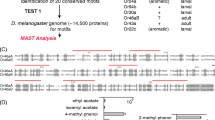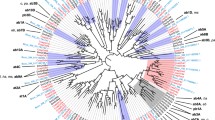Abstract
Olfactory information is transmitted to the brain using combinatorial receptor codes; consequently, a single reception element can be activated by different odorants. Several methods have been applied to describe from a functional point of view those odorants sharing olfactory reception components. A genetic approach in Drosophila melanogaster used correlation between behavioral responses to different odorants for deducing common olfactory pathway-genes. A factor analysis applied to behavioral responses to five odorants of 27 antennal enhancer-trap lines revealed three components, explaining 82.1% of the total observed variance. A first factor affects simultaneously the response to ethyl acetate, propionaldehyde, and acetone. A second factor was related to responses to ethyl acetate, ethyl alcohol, and acetone, and, finally, the third factor associates responses to acetic acid and ethyl acetate. They contribute by 35.1%, 36.9%, and 28%, respectively, to the explained variance.
Similar content being viewed by others
REFERENCES
Alcorta E., and Rubio, J. (1988). Genetical analysis of intrapopulational variation in olfactory response in Drosophila melanogaster. Heredity 60:7–14.
Alcorta E., and Rubio, J. (1989). Intrapopulational variation of olfactory responses in Drosophila melanogaster. Behav. Genet. 19:285–299.
Bargmann, C. (1997). Olfactory receptors, vomeronasal receptors, and the organization of olfactory information. Cell 90:585–587.
Bieber, S. L., and Smith, D. V. (1986). Multivariate analysis of sensory data: A comparison of methods. Chemical Senses 11:19–47.
Boekhoff, I., Tarelius, E., Strotmann, J., and Breer, H. (1990). Rapid activation of alternative second messenger pathways in olfactory cilia from rats by different odorants. EMBO J. 9:2453–2458.
Borst, A. (1984). Identification of different chemoreceptors by electroantennogram-recording. J. Insect Physiol. 30:507–510.
Brand, A. H., and Perrimon, N. (1993). Targeted gene expression as a means of altering cell fates and generating dominant phenotypes. Development 118:401–415.
Breer, H., Boekhoff, I., and Tareilus, E. (1990). Rapid kinetics of second messenger formation in olfactory transduction. Nature 345:65–68.
Breer, H., Wanner, I., and Strotmann, J. (1996). Molecular genetics of mammalian olfaction. Behav. Genet. 26:209–219.
Buck, L., and Axel, R. (1991). A novel multigene family may encode odorant receptors: A molecular basis for odor recognition. Cell 65:175–187.
Clyne, P. J., Warr, C. G., Freeman, M. R., Lessing, D., Kim, J., and Carlson, J. R. (1999). A novel family of divergent seven-transmembrane proteins: Candidate odorant receptors in Drosophila. Neuron 22:327–338.
de Bruyne, M., Clyne, P. J., and Carlson, J. R. (1999). Odor coding in a model olfactory organ: The Drosophila maxillary palp. J. Neuroscience 19:4520–4532.
Derby, C. D., and Ache, B. W. (1984). Quality coding of a complex odorant in an invertebrate. J. Neurophysiol. 51:906–924.
Dubin, A. E., Heald, N. L., Cleveland, B., Carlson, J. R., and Harris, G. L. (1995). Scutoid mutation of Drosophila melanogaster specifically decreases olfactory responses to short-chain acetate esters and ketones. J. Neurobiology 28:214–233.
Duchamp, A., and Sicard, G. (1984). Odour discrimination by olfactory bulb neurons: Statistical analysis of electrophysiological responses and comparison with odour discrimination by receptor cells. Chemical Senses 9:1–14.
Fuyama, Y. (1978). Behavior genetics of olfactory responses in Drosophila. II. An odorant-specific variant in a natural population of Drosophila melanogaster. Behav. Genet. 8:399–414.
Hekmat-Scafe, D., Steinbrecht, R. A., and Carlson, J. R. (1997). Coexpression of two odorant-binding protein homologs in Drosophila: Implications for olfactory coding. J. Neuroscience 17:1616–1624.
Kim, M. S., Repp, A., and Smith, D. P. (1998). LUSH odorant-binding protein mediates chemosensory responses to alcohols in Drosophila melanogaster.Genetics 150:711–721.
Leinders-Zufall, T., Greer, C. A., Shepherd, G. M., and Zufall, F. (1998). Imaging odor-induced calcium transients in single olfactory cilia: Specificity of activation and role in transduction. J. Neuroscience 18:5630–5639.
Malnic, B., Hirono, J., Sato, T., and Buck, L. B. (1999). Combinatorial receptor codes for odors. Cell 96:713–723.
Ngai, J., Dowling, M. M., Buck, L., Axel, R., and Chess, A. (1993). The family of genes encoding odorant receptors in the channel catfish. Cell 72:657–666.
Raming, K., Krieger, J., Strotmann, J., Boekhoff, L., Kubick, S., Baumstark, C., and Breer, H. (1993). Cloning and expression of odorant receptors. Nature 361:353–356.
Revial, M. F., Sicard, G., Duchamp, A., and Holley, A. (1983). New studies on odour discrimination in the frog's olfactory receptor cells. II. Mathematical analysis of electrophysiological responses. Chemical Senses 8:179–194.
Riesgo-Escovar, J., Woodard, C., Gaines, P., and Carlson, J. (1992). Development and organization of the Drosophila olfactory system: An analysis using enhancer traps. J. Neurobiol. 23:947–964.
Rouquier, S., Taviaux, S., Trask, B. J., Brand-Arpon, V., van den Engh, G., Demaille, J., and Giorgi, D. (1998). Distribution of olfactory receptor genes in the human genome. Nature Genetics 18:243–250.
Schild, D., and Restrepo, D. (1998). Transduction mechanisms in vertebrate olfactory receptor cells. Physiol. Rev. 78:429–466.
Troemel, E. R., Chou, J. H., Dwyer, N. D., Colbert, H. A., and Bargmann, C. I. (1995). Divergent seven transmembrane re-ceptors are candidate chemosensory receptors in C. elegans. Cell 83:207–218.
Vogt, R. G., Prestwich, G. D., and Lerner, M. R. (1991). Odorant-binding-protein subfamilies associate with distinct classes of olfactory receptor neurons in insects. J. Neurobiol. 22:74–84.
Vosshall, L. B., Amrein, H., Morozov, P. S., Rzhetsky, A., and Axel, R. (1999). A spatial map of olfactory receptor expression in the Drosophila antenna. Cell 96:725–736.
Wang, Q., Hasan, G., and Pikieelny, C. W. (1999). Preferential expression of biotransformation enzymes in the olfactory organs of Drosophila melanogaster, the antennae. J. Biol. Chemistry 274:10309–10315.
Author information
Authors and Affiliations
Corresponding author
Rights and permissions
About this article
Cite this article
Martin, F., Kim, MS., Hovemann, B. et al. Factor Analysis of Olfactory Responses in Drosophila melanogaster Enhancer-Trap Lines as a Method for Ascertaining Common Reception Components for Different Odorants. Behav Genet 32, 79–88 (2002). https://doi.org/10.1023/A:1014464013844
Issue Date:
DOI: https://doi.org/10.1023/A:1014464013844




